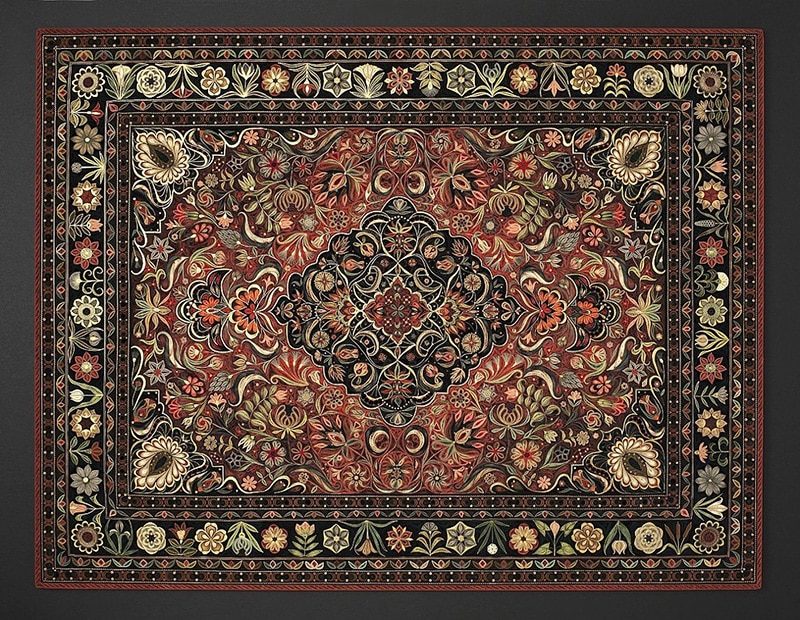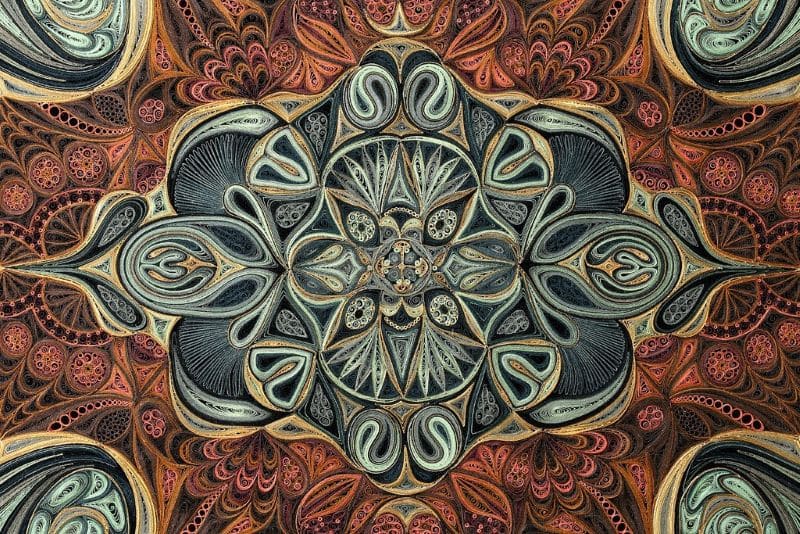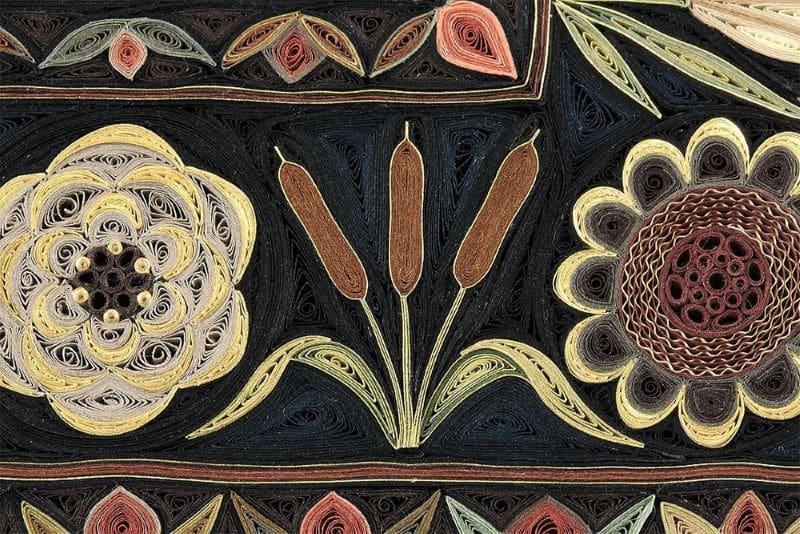Lisa Nilsson Creates Magnificent Carpets from Paper
The art of paper quilling is believed to have begun in the 15th century. It was created by French and Italian nuns to decorate special religious objects. Lisa Nilsson is a contemporary artist who takes this art form to new levels, creating magnificent renditions of Persian carpets using only compact coils of Japanese mulberry paper.
Nilsson takes her inspiration from ancient texts and Islamic carpets. The pieces are intricate, and it takes her about eight months to complete a work that fills a 27 x 34-inch frame. She says that much of the work is improvised, but it is difficult to see because the works appear to be carefully planned.
The quill-work carpets that Nilsson creates are as beautiful and transcendent as the woven carpets that inspired them. The colors are rich and warm, using familiar carpet patterns such as medallions, pendants, formal corners, and complex, layered borders. From a distance, it is difficult to see the difference between one of her paper creations and a real Oriental rug.

Lisa Nilsson working in her studio.
Lisa Nilsson: Inspired by Historical Roots
The inspiration for Nilsson’s work draws from historical sources in both the media used and the subject matter. Paper quilling began in the 14th century as a way for nuns to decorate sacred objects cheaply. The work was meant to mimic wrought iron and carved ivory. Often, the paper would be gilded so that you could barely see the difference between the real metal and the quilled work.
Quilling reached its peak in popularity in 18th century England when young ladies were taught the art as an appropriate pastime, second only to embroidery. It was taught in schools and was considered a popular leisure activity that was not too “taxing” on the mind.

Lisa Nilsson’s paper quilling carpet
The art of making pile carpets has been around for several thousand years, but it reached its artistic peak in the 15th century. The rulers of the Safavid Dynasty in Persia established schools and a formal weaving industry to create the splendid works of art that graced the floors and walls of palaces, mosques, and the homes of the aristocracy. It was during this time that many traditional patterns and designs that Nilsson draws upon were created.
The quilled paper artwork of Lisa Nilsson combines two mediums that were different worlds from a historical perspective. Her use of these familiar mediums creates a new expressive outlet for both of these mediums. One has to agree that the results are mesmerizing.

Lisa Nilsson paper quilling detail.
Life and Work of Lisa Nilsson
Nilsson was born in 1963 in Massachusetts. She received a Bachelor of Fine Arts in illustration from the Rhode Island School of Design in 1985. Creating things came naturally, as she grew up in a family of creators who sewed, painted, worked with watercolors and mixed colors for false teeth. Her father was a graphic designer, and her brother was an illustrator.
Her first job after graduation from art schools was as an illustrator for American Greetings. She later worked as a freelance illustrator for Rolling Stone, Entertainment Weekly, Sports Illustrated, and the Utne Reader. Later, she moved to North Adams, Massachusetts, to live and work in a renovated textile mill with other working artists. It was here that she began making small-scale works from assembled pieces. This led to her first show at the Massachusetts Museum of Contemporary Art in 2010.

Quilled paper rug by Lisa Nilsson.
In 2010, Nilsson took an extended leave from art to attend a medical assisting program at a local technical school. This added to her lifelong interest in the human body and how the various parts interconnect. It was during this time when Nilsson began working with quilled paper as a medium.
She first discovered quilling when she found a Victorian quilled piece in a junk shop, and she liked the way the quilled paper shapes behaved as a medium. The piece was an ornate cross, and she was fascinated by the design.
Since that time, the artist has taken the quilled paper to entirely new levels of artistry and detail. She now has pieces in galleries and shows across the country. She has done solo shows at Pavel Zoubok Fine Art in New York and has had a booth at EXPO Chicago 2017. Nilsson’s two most famous series are the Persian carpets, many of which now reside in private collections, and her anatomical series. In this series, the artist recreated anatomical cross-section in accurate detail using quilled paper.
Her carpets were created for a series entitled “Tapis,” which is the French word for tapestry. From a distance, her amazing creations look just like a Persian carpet. It is not until you get up close that you realize that the “carpet” is created from carefully coiled pieces of paper.

Close up view of Lisa Nilsson’s paper quilling carpet.
The Paper Quilling Process of Artist Lisa Nilsson
The process for making these extraordinary quilled paper pieces begins with carefully curling and crimping quarter-inch strips of mulberry paper and then crimping and bending them into shapes. All of the pieces start from the center and work outward. Each of the sections is arranged, and the exquisite patterns soon begin to emerge.
Rather than starting with a preconceived plan, Nilsson allows the process to guide her, with each layer emerging as a result of the previous one. The process is tedious and time-consuming. Each one takes months to complete. One of the more fascinating characteristics of Nilsson’s work is that you can find intricate, swirling shapes in the negative spaces and backgrounds of the creations that add another dimension to the work. The final piece is surrounded by a rectangular frame.
Her idea to create the “Tapis” series began when she was looking at auction-house catalogs and was inspired by the beautiful Persian carpets. At that time, she was working on a series of anatomical pieces and wanted a break. She was drawn to the structure of the central medallions of the carpets. She was also drawn to the structured approach of the carpet artist with the formal corners, pendants, and series of borders.

A closer look at Lisa Nilsson’s work, “Jardin”.
She began to see the designs for the various components that fit together to create the whole. This is what attracted her to the idea of combining the intricate quilled shapes and the art of Persian carpets. What she likes most about the carpets is watching them evolve over time and how each little piece fits into the whole.
Nilsson is not a person who tends to plan her life too far ahead, but she does see allowing this new geometric form continuing to evolve over time. As for the rest of us, we will continue to enjoy her work and the magnificent carpets that inspire it. We will just have to wait and see how Nilsson’s work evolves next.
This art blog about artist Lisa Nilsson and her Islamic paper quilling Islamic carpets was published by Nazmiyal Antique Rugs.



